
|   |

|   |
Twamaham Vande, Chakrayatra to Mahavidya and Aanantya - Manjari Sinha e-mail: manjari@sinha.com April 6, 2024 'Twamaham Vande', a dance production by Jalsa Chandra Performing Troupe, 'A Journey from Chakrayatra to Mahavidya' by Sayani Chakraborty and Santanu Roy, and 'Aanantya: Honouring the Immortal Art', an all-women music and dance ensemble presented by Nitisha Nanda were the three recent attractions of dance, in Delhi. TWAMAHAM VANDE Photos: Sanjit Debroy 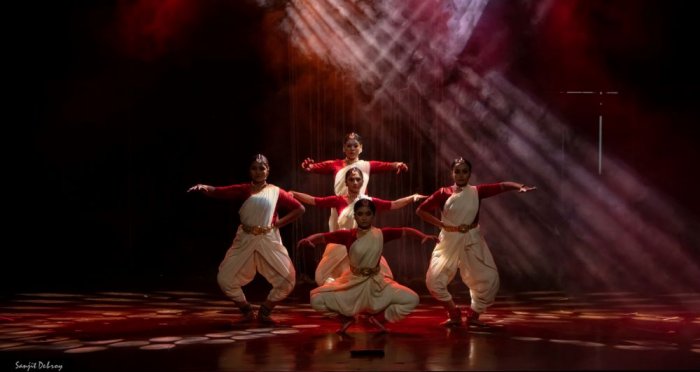 Jalsa Chandra Performing Troupe 'Twamaham Vande' presented by Jalsa Chandra Performing Troupe from Kolkata, at the Habitat Centre was about tracing the roots of bhakti from Vedic hymns to the devotional poetry of saint poets. Starting with the Nasadiya Sukta from Rigveda to the shlokas of Bhagavad Gita, Dohas of Kabir, the Baul songs of Lalon Fakir to Tulasidas Bhajan, Abhang of Tukaram, Thevaram praising Shiva, and the concluding verses from Mandukopanishad, the show explored bhakti in myriad ways. The Nasadiya Sukta from Rigveda opened with a group choreography portraying Srishti, Sthiti, and Samhar. The tangential rays of Srishti (creation) were depicted by the diagonal movements and the Pancha Nadai describing creation. The 'Sthiti' showed how the abundance of creation leads to slow down and negativity. Verses of 'Geetopadesham' spoke of Karma Yoga because the only way to live life is to keep doing one's own Karma against the cyclical process of Srishti - creation, Sthiti - abundance, and Samhar - destruction. 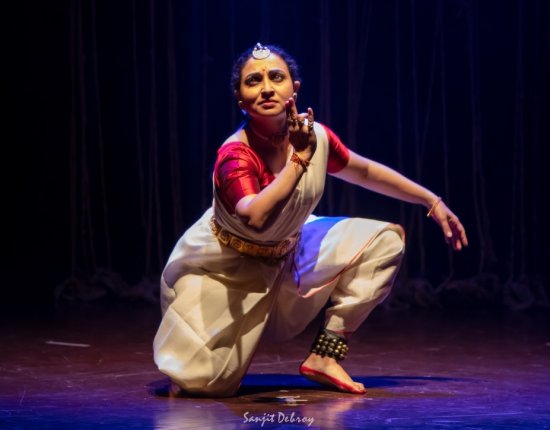 Jalsa Chandra The Doha of Sant Kabir, "Patta bola vriksha se...Yahi jagat ki reet" endorsed the same idea that the cycle of life is constant, and realizing it with acceptance is the only way to inner peace. This philosophy was also portrayed through a solo abhinaya by Jalsa. Baul songs of Lalon Fakir preach the theory of the physical body, the 'Deha Tattwa' and the arising of the Muladhar chakra, going through nine levels to reach the 'Parakashtha', the climax in the union with the Parabrahman performed by the troupe. The Tulsidas Bhajan "Kahan ke pathik tum..." did not quite gel with the theme but Jalsa justified it by saying, "I used this as the title line for this journey of life, where we all are travellers. One constant factor that prevails is faith. Sita was born out of earth. She was doubted, put to trial, and finally, she returned to Mother Earth; but Rama was in her every breath. My choreography around Sita conveys, if your faith is firm, undaunted, you will be able to cross the trials of life with strength." 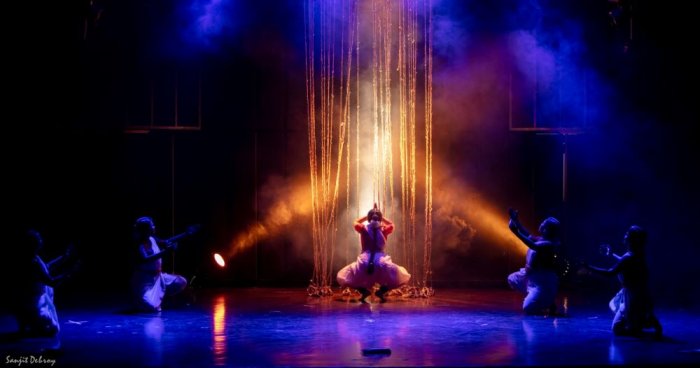 Jalsa Chandra Performing Troupe The Abhang of Sant Tukaram was a Ninda Stuti of Panduranga underlining the beauty of Hindu religion, which gives you the liberty to satirize even your God. The Thevaram by Shaivite saint in praise of Shiva described Shiva riding the Nandi. The group dance incorporated stories of Neelkanta and Tripura Dahan curbing the 'Shada Ripu' and three Gunas with the procession bringing him inside the temple garbhagriha (sanctum). The concluding verses from the Mandukopanishad state, "Just as the rivers merge with the ocean forgetting their names and identities, similarly wise men merge with the Divine." The concept, choreography, and direction by Jalsa Chandra had consultant Shreejith Dutta, inputs by Shankar Lal Mehta, narration by Gauri Basu, production designer Utsab Ganguli, music arrangement by Shankar Narayanaswamy and light design by Saumen Chakraborty. 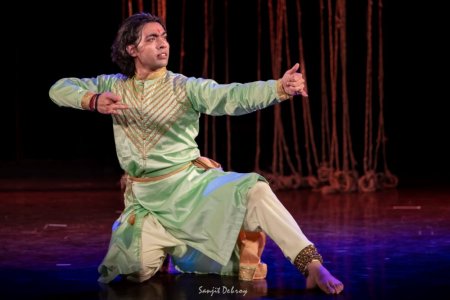 Sangeet Gangani The second half of the evening featured Sangeet Gangani, the talented son and disciple of Pt. Rajendra Gangani, in a solo Kathak performance. Opening with an invocation to Shiva "Mahesham Suresham..." he presented the impressive nritta segment in Jhaptaal with 'Band-Haath ka Thaat', Aamad, Tode Tukde, Tihai and a Lamchhad (long) Ganga Paran. The concluding Ram Bhajan for abhinaya culminated in Tatkaar, with crisp footwork. Sangeet was accompanied by an all-Gangani orchestra comprising Nisheeth on tabla, Aashish on pakhawaj, and Vinod on harmonium and vocals. A JOURNEY: CHAKRAYATRA TO MAHAVIDYA Kolkata based Bharatanatyam dancers Santanu Roy and Sayani Chakraborty presented their dance production 'A Journey: Chakrayatra to Mahavidya' at the C.D. Deshmukh Auditorium of India International Centre (IIC), Delhi. Santanu, a promising young Bharatanatyam performer and teacher from Kolkata is a talented disciple of Samrat Dutta who has also attended classes of Prof. C.V. Chandrasekhar in Chennai. A graded artist of Doordarshan with a Master's degree in Bharatanatyam from Thanjavur's Tamil University, he is also co-director of Bandish Arts founded by Swathi Athmanathan in Chennai. Sayani is a Bharatanatyam dancer from Kolkata who is honing her craft under the tutelage of Rama Vaidyanathan. A graded artiste of Doordarshan, she had participated in numerous dance festivals at home and abroad. Delving deep into the intricacies of Bharatanatyam, she strives to share its essence with audiences far and wide. The program opened with a completely dark stage, light falling on Sayani and Santanu both in the centre, emerging with the auspicious sound of the conch, the 'Shankha Dwani'! The innovative duet, conceptualized as the 'Shree-Yantra Alarippu' explored the space, the Tattvas, and the concentric power of Devi, who sits coiled like a serpent amidst the circle. Choreographed by Sayani and Santanu together and danced as a duet with striking anga shuddhi and vigour, it was presented as a preface to the dance production. 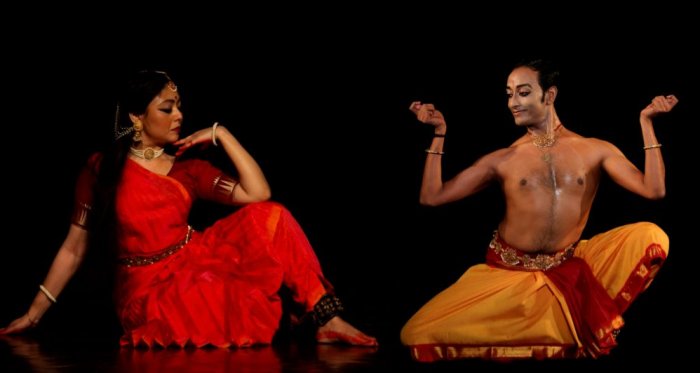 Sayani Chakraborty & Santanu Roy 'Chakra Yatra - Journey towards the Mystical Eye', a solo by Sayani, was a journey of the unmanifested soul. The Shakti stays dormant like a coiled serpent. The Brahmanda lies inside her, but her closed eyes can't realize its ultimate ecstasy. It is the inner transformation of Parvati, the Kundalini Shakti herself, to unite with the higher consciousness, Shiva. The quest begins when the snake rises to the Manipura Chakra, and her utmost passion for the Supreme creator touches its peak, but her lust falls rejected as his ashes. Parvati transcends her true self within the Vishuddhi Chakra, as all her passion, desires, and materialistic manipulation fail in front of that divine energy. The song by Tagore "Kar milono chao birohi" underlines her realisation of the self. His damaru was the constant rhythm in her heart. She looks within and her soul blooms like the lotus, 'chit kamal,' the Sahasrar thousand petals. The Tagore song echoes inside her to finally unite with the Supreme. She embraces the holy ashes and becomes one with the supreme consciousness. 'Anandam' unfolds leading her to the ultimate bliss. The journey from the Muladhara chakra started with Sargam in raga Bhathiyar to Swadhishthan Chakra in Bihag, and Manipura chakra in Shuddha Sarang set to talam Chatusra Ekam. Raga Shree was imaginatively used for the Vishuddhi Chakra through the Bangla Geet, and Tillana for reaching the climax of the Sahasrar chakra, when Devi becomes Shivakara herself! The recorded music for 'Chakra Yatra' had music composition and creative inputs by Dr. Sridhar Vasudevan, who also provided vocal support. Mridangam was by Sarvesh Kartik, nattuvangam - Ashwin Subramanian, violin - Vishwesh, Sanskrit verses written by Divyanand Jha, narration and scholarly insights on Shakti by Dr. Himanshu Srivastava. Overall support and guidance was by Rama Vaidyanathan who tells that the concept and choreography were by Sayani Chakraborty. 'Dasha Mahavidya' by Santanu was a researched choreographic work depicting the ten forms of Parashakti, according to Tantra. Worshipped parallel to the Dashavatara, the ten Devis are Kamala, Kali, Tara, Vagalamukhi, Bhairavi, Bhuvaneshwari, Dhumavati, Matangi, Chinnamasta, and Shodashi. Set to Dasha Ragamalika and Taalamalika, this piece was originally conceived and choreographed by Santanu's Guru Samrat Dutta. Santanu portrayed them as a reflection of the ultimate human life, and human emotions (the nine rasas), along with their Dhyana Mantras. Due to paucity of time, he could depict just six of these Mahavidyas namely Devi Kamala, Goddess Kali, Bagalamukhi, Bhairavi, Chinnamasta and Tripurasundari. Sayani joined him in the end as Tripureshwari when Santanu, the devotee, worshiped her as Tripureshwari / Maheshwari in raga Vasanta. 'A Journey: Chakrayatra to Mahavidya' was part of the Double Bill Concert series of the IIC and the second half featured Dipti Bansal, a disciple of Savita Devi, who presented Thumri, Dadra, and Hori compositions accompanied by Bharat Bhushan Goswamy on sarangi, Shaukat Ali on tabla and Ravi Pal on harmonium. 'AANANTYA', HONOURING THE IMMORTAL ART Photos: One Frame Story Tapaswini Nav Sadhana (TNS), an NGO educating and supporting the underprivileged with all its centers run by women, presented 'Aanantya' at the Chinmaya Mission auditorium. The term 'Aanantya' means never ending and it aptly sums up the 'art', which is endless, limitless. Similarly, the Guru Shishya Parampara is also strung in an endless cycle of past, present and future. 'Aanantya' was a celebration of this immortal Art tradition, specifically Odissi, the classical dance form kept alive with its transmission through Guru Shishya Parampara. 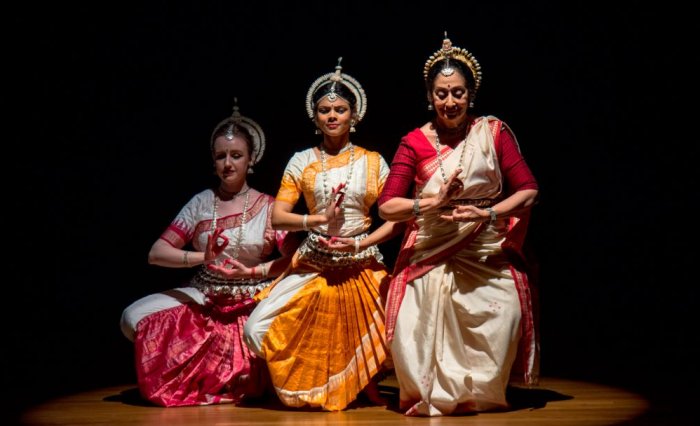 Perrine Legoullon, Nitisha Nanda & Sharon Lowen Presented on the occasion of International Women's Day, 'Aanantya' was a special celebration of Odissi dance, music, and women, brought together by seven women artistes looking into their infinite art journeys. 'Aanantya' featured Guru Sharon Lowen, Nitisha Nanda and Perrine Legoullon, an unbroken chain of Guru and Shishya, teacher and disciple, sharing their journey into art through dance and music along with an all-women ensemble accompanying them. Nitisha Nanda, the enthusiastic and capable secretary of TNS, is an Odissi artiste, who was initiated into Odissi with Guru Harekrushna Behera, and then trained under Guru Ipsita Behoora, who was a disciple of Sanjukta Panigrahi and Guru Kelucharan Mohapatra. She is further groomed under the tutelage of Guru Sharon Lowen. Nitisha is a graded Doordarshan artiste, empaneled with the ICCR. She has travelled to teach and perform at various dance festivals and institutes at home and abroad. Nitisha is awarded the Karamveer Puraskar for social justice and citizen action. Unlike regular recitals, the intention of 'Aanantya' was to go 'beyond the artist', giving the audience a chance to connect not just with the art form, but also the source that nurtures it. Each of the seven artistes shared their journey into art - whether it was about a memory with their Guru, their upbringing, experiences, or their learnings over the years. It was not just an insight into their art but also a personal connect that the audience could relate to. Poorvaja, the artistic director of Aanantya, a music/dance therapist and psychiatrist, spoke about how the multiple roles in life connected her mind, body, and soul. Namrata, the pakhawaj player shared her fond memories with her teachers, Guru Banamali Maharana and Dhaneshwar Swain, and her experience of learning the Battu first time in complete darkness without electricity. Nathalie, the flautist, shared how she has trained in both Western classical and Indian classical flute and how she connects colours to art. Asawari, the vocalist, shared her mother's dedication to travel with her for fifty kilometres so that her daughter got trained in music, and how she now resonates with her name, which is named after a Raga. 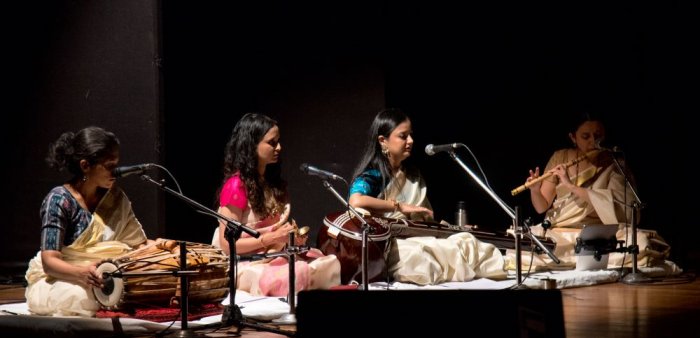 The music ensemble The three generations of Guru-Shishya dancers Sharon, Nitisha, and Perrine shared their insights into Odissi, their chosen dance form. Perrine, trained under Nitisha, spoke about the simple decision to move to India from France solely to study dance, and her stay in this country to continue her pursuit. She spoke of how her teacher's constant belief in her, taught her to believe in herself. Nitisha shared her journey with multiple teachers and how that taught her the beauty of starting anew. Each teacher started a different journey, making her surrender and not worry about what lay ahead. Guru Sharon Lowen stated her free approach while teaching, not holding her students too tight, and allowing them to flourish in their own journey. Each artiste came up with a different approach to what art meant to them. Going 'beyond the artist' and connecting with them individually, was a refreshing experience for most people. Nitisha, who conceived and curated the show concluded, "I wanted to celebrate every artist, which felt like the most honest way to celebrate the art that ties us all." The evening opened with the invocatory "Gurave Namah" and "Sah naavavatu, Sah nau bhunaktu..." with the tuneful drone of tanpura and flute. Odissi dance recital was interspersed with the insightful experience nuggets shared by individual artistes. For instance, the invocation was followed with Namrata speaking about Guru Banamali Maharana's training and Perrine Legoullon shared how she came in 2018 from France with no background of music and dance but just a desire to learn dance and how her Guru encouraged and trained her before presenting the Battu choreography of Guru Kelucharan Mohapatra with music by Pt Bhubaneswar Mishra. Nitisha took the stage thereafter and said, "You meet your Guru when you are ready for this journey." She gave a melodious surprise with 'Madhumas', a choreographic ode to the Spring season, dancing to Western music composition on Western flute played with the musical accompaniment of a tuneful tanpura. The notes of Major Scale also gave way to Hindustani ragas in a 'Call-Response' (Sawal-Jawab) sequence. Nitisha deserves kudos for the fresh approach to this imaginatively composed and choreographed innovative presentation. Sharon talked about her Manipuri dance background where the abhinaya doesn't involve facial expressions and how challenging it was to do it in Odissi, before presenting Jayadeva's ashtapadi "Kuru Yadunandana" with intense involvement and subtlety. It was melodiously sung by Asawari with the pleasing flute and the resonant tanpura. 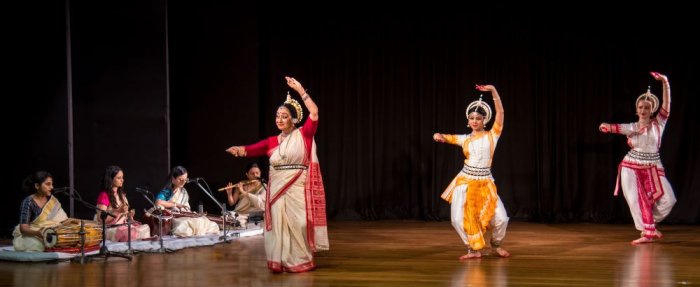 The three generations came together for the concluding 'Moksha', the spiritual liberation, in the serene swaras of Bhairavi, with Sharon Lowen, Nitisha Nanda, and Perrine Legoullon dancing together. The program was followed by an interesting interaction with the audience, who unanimously heralded the 'Nari Shakti'! 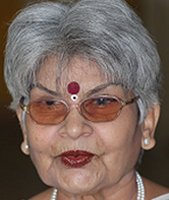 Manjari Sinha has an M.A. in Sanskrit and Music, and Sangeet Prabhakar in vocal, tabla, sitar and Kathak dance. She has regular columns in national dailies as a music and dance critic. |